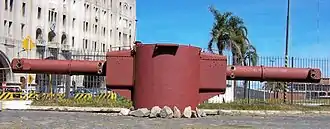Rangefinding telemeter
The rangefinding telemeter (or simply telemeter, depending on the context), is a device used to measure distances to remote objects, that is, a type of rangefinder. The name is derived from the Ancient Greek: τῆλε tēle "far away" and μέτρον métron "something used to measure". Originally optical devices used in surveying, they soon found applications in other fields, such as photography and in the military. They were specially useful for finding the range of a target, such as in naval gunnery and anti-aircraft artillery.

Designs

World War II era telemeters worked optically with two telescopes focused on the same target but a distance apart along a baseline. The range to the target is found by measuring the difference in bearing of the two telescopes and solving the skinny triangle. Solutions can be obtained automatically, using tables or, rarely, manual calculation. The greater the distance to the target, the longer the baseline needs to be for accurate measurement. The baseline required for the telemeters for battleship guns is very large. More modern telemeters use an electronic technology such as lasers or radar.
The first rangefinder telemeter was invented by James Watt in 1769 and put to use in 1771 in surveying canals. Watt called his instrument a micrometer, a term now used with a different meaning in engineering. It consisted of two parallel hairs in the focal plane of a telescope eyepiece crossing an upright hair. At the point to be measured, two sliding targets on a surveyor's rod were adjusted to align with the hairs in the telescope. The distance to the rod could then be determined from the distance between the targets on the rod by trigonometry [1] (p. 56, 75-76).
Several others have been credited with the invention of the rangefinder telemeter at one time or another. The Royal Society of Arts gave an award to W. Green for its invention in 1778, even though they were made aware of Watt's priority[1] (p. 76-77).
In 1778 Georg Friedrich Brander invented the coincidence telemeter. Two mirrors set a distance apart horizontally in a long slim box, similar to a subtense bar but located at the measuring station, and forming two images. This rangefinder does not require a measuring rod at the target and could perhaps be considered the first true telemeter. In 1790 Jesse Ramsden invented a half-image range finder. Alexander Selligue is often mistakenly credited with the invention, he did invent an improved telemeter with fixed lenses in 1821 and is responsible for coining the term.[2][3]
In 1899 Carl Pulfrich at Carl Zeiss AG fabricated a practical stereoscopic rangefinder[4] (p.15), based on a patent of Hector Alexander de Grousilliers.[5]
See also
- Coincidence telemeter
- GfK-Telemeter, a device to determine the viewing rate
- Stereoscopic telemeter
- Telemeter chronograph
References
- H. W. Dickinson, James Watt: Craftsman and Engineer, Cambridge University Press, 2010 ISBN 110801223X.
- Johann Gottfried Dingler, Polytechnisches Journal, vol. 8, page 121, Stuttgart: Cotta 1822 OCLC 183328327 (in German)
- A. Rittig von Flammenstern, Archiv für Geographie, Historie, Staats- und Kriegskunst, vol. 13, Franz Härter: Wien, page 561 (in German)
- Fritz Deumlich, Surveying Instruments, Walter de Gruyter, 1982 ISBN 3110077655
- GB patent 189317048, Hector Alexander de Grousilliers, "Improved Stereoscopic Telemeter.", issued 1894-07-14